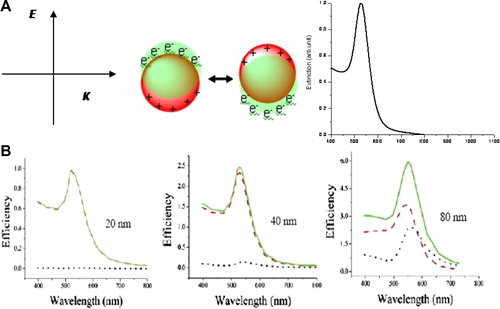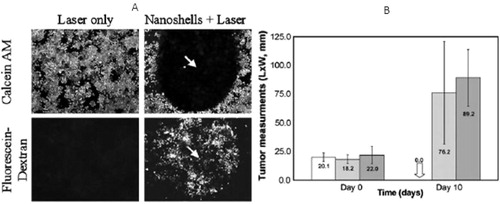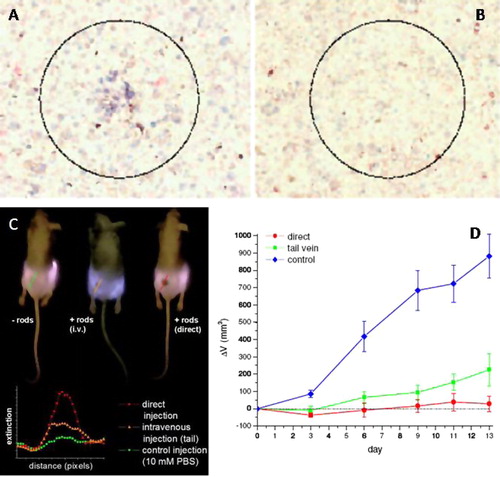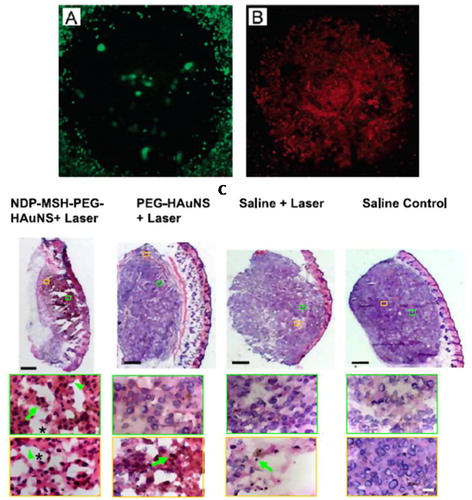Figures & data
Figure 1 Schematic illustration of localized surface plasmon resonance (A) and calculated absorption and scattering properties of gold nanoparticles in different sizes (B). The electric field of incident light induces coherent collective oscillation of conduction band electrons with respect to the positively charged metallic core. This dipolar oscillation is resonant with the incoming light at a specific frequency that depends on particle size and shape. The absorption and scattering efficiencies depend on the size of the nanoparticles. Increasing nanoparticle size leads to an increase of light scattering contribution. (A) Reproduced with permission from Huang et al.Citation4; (B) reproduced with permission from Jain et al.Citation6

Figure 2 NIR-absorbing Au NPs in PPTT of cancer. Left column: Au NSs. Reproduced with permission from Loo et al.Citation7; Middle column: Au NRs. Reproduced with permission from Huang et al.Citation4; Right column: Au NCs. Reproduced with permission from Hu et al.Citation8; First row: schematic illustration of the structures of Au NSs, NRs and NCs; Second row: TEM images; Third row: surface plasmon extinction spectra. The surface plasmon band is tuned to the NIR region by changing the shell to core ratio, the aspect ratio and the particle size, wall thickness and wall porosity for Au NSs, NRs and NCs, respectively.

Figure 3 NIR PPTT using Au NSs. (A) In vitro PPTT; (B) in vivo tumor PPTT. Blank: NSs and laser treatment; Gray: shame treatment; Dark: untreated controls. While laser itself does not affect the cell viability, the treatment of Au NSs induces cell death within the laser irradiation area at a laser intensity of 37 W/cm2. Tumors are completely ablated for the NSs and laser treated groups, but not shame and control groups. (A) Reproduced with permission from Hirsch et al.Citation37; (B) reproduced with permission from O’Neal et al.Citation38

Figure 4 NIR PPTT using Au NRs. (A and B) Selective in vitro photothermal cancer therapy; (C and D) in vivo NIR tumor imaging and PPTT therapy. At 10 W/cm2, the cancer cells within the laser spot undergo irreversible photodestruction (A) while the normal cells are not affected (B). The tumors are identified by a black spot under NIR illumination due to the light absorption by the nanorods that are administrated into the tumor either intratumorally or intravenously. NIR irradiation of the nanorod treated tumors leads to significant inhibition of the tumor growth rate compared to control tumors. (A and B) Reproduced with permission from Huang et al.Citation41; (C and D) reprinted with permission from Dickerson et al.Citation44

Figure 5 NIR PPTT using Au NCs. (A and B) In vitro PPTT; (C) in vivo tumor tissue destruction assessed by histologic staining. Only for the active targeted and laser treated tumors, tumor cells show extensive pyknosis (arrows), karyolysis (arrowheads), cytoplasmic acidophilia, and degradation of the extracellular matrix of the tumor (asterisks). (A and B) Reproduced with permission from Chen et al.Citation46; (C) reproduced with permission from Lu et al.Citation49
